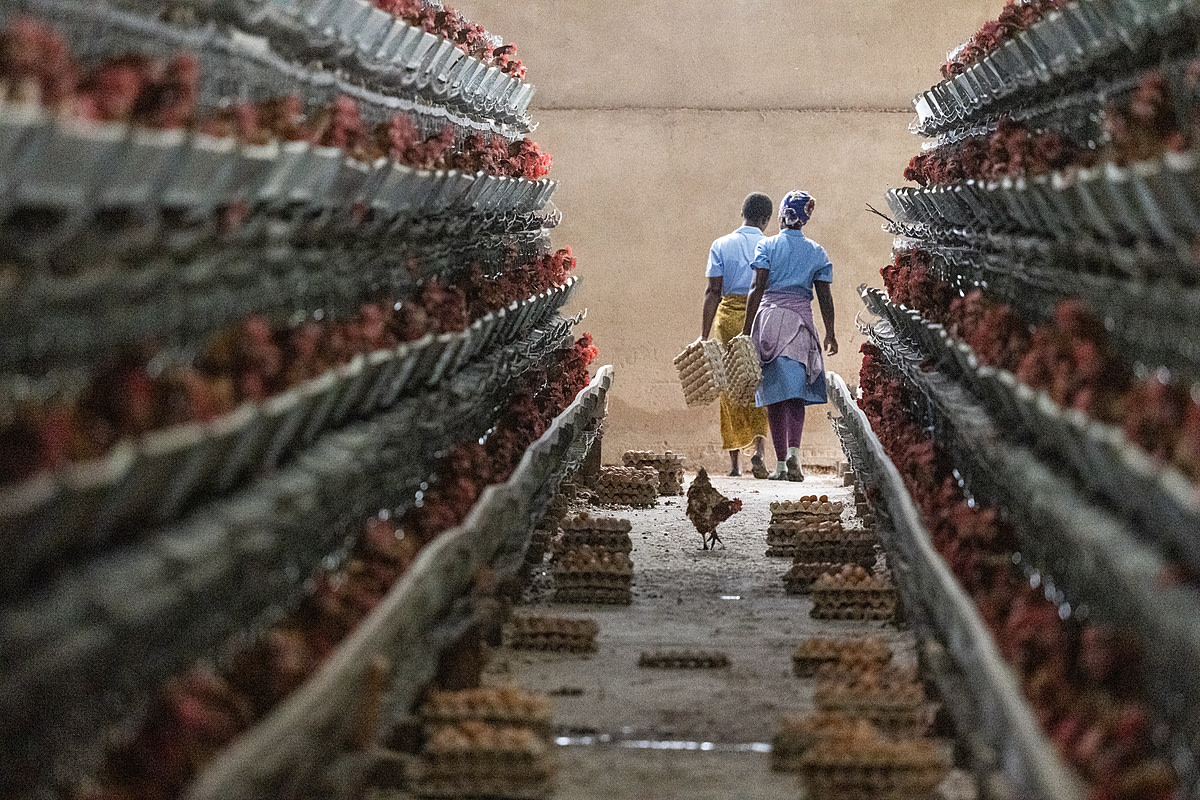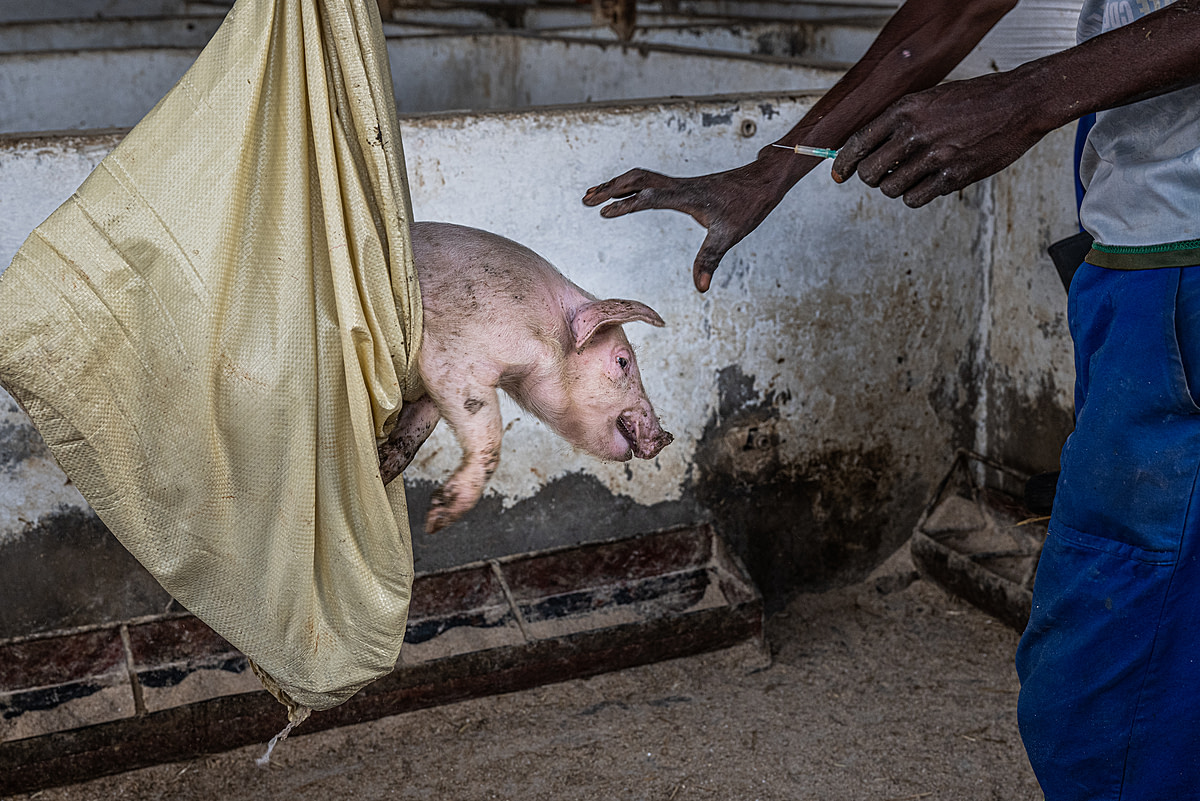The Rise of Industrial Animal Farming in Africa
Photographer: Jo-Anne McArthur
Author: Jo-Anne McArthur
Explore and download more visuals from this collection via our stock platform.
From small farms holding a few hundred pigs in barren pens to cramped sheds holding 24,000 birds in each, I came home with visuals that show a diversity of how people and companies are keeping animals. I spoke with farmers about the trends in farming, and they all pointed toward intensification. “It’s not very kind for the birds,” a hen farmer explained, “but people don’t have purchasing power so eggs must be produced as cheaply as possible.”
A farm worker fills large food dispensers with feed in a crowded barn holding 1,200 visibly balding floor-raised hens used for egg production. Chaos ensues as the birds clamber and crowd around him to eat. Sub-Saharan Africa, 2022. Jo-Anne McArthur / We Animals Media
Workers at an industrial egg production farm collect eggs from hens housed in battery cages. Each cage is intended to hold up to three hens, but four or five hens per cage were often visible. Each barn on this farm holds 24,000 hens. Sub-Saharan Africa, 2022. Jo-Anne McArthur / We Animals Media
The industrial farming of animals is on the rise on the African continent, and this is mobilizing animal and environmental advocacy organizations. The photos and videos of this worrisome trend that I created alongside my African colleagues will serve to help campaigners, educators and legislators to address the problem of a trend that could be stopped or reversed before it is entrenched, as it is in the west.
A young piglet sits in a sack on an intensive pig farm to be weighed and vaccinated before being moved to a pen. Sub-Saharan Africa, 2022. Jo-Anne McArthur / We Animals Media
We kept a busy schedule of farm visits, and I returned home with pictures of caged hen facilities, floor-raised hen farms, broiler chicken farms, pig farms both small and large, fish farms and backyard animal projects that included ducks, turkeys, goats and rabbits. We visited farms owned by massive national companies: some had a hundred animals, while others had thousands. In some cases I was not granted permission to shoot, but conversations with farm managers still took place. “The future of pig farming is bright,” one young manager proclaimed after a farm tour in which the pigs were kept packed into filthy concrete pens.
Two rows of sows, encrusted with filth, live in bare concrete-floored gestation crates inside an intensive pig farm barn. The sows can only stand, sit, and lie down in these small crates. They cannot move forward, backward or turn around. Sub-Saharan Africa, 2022. Jo-Anne McArthur / We Animals Media
A bull calf sleeps in a mixture of wet mud and feces inside a cattle fattening yard, also known as an Animal Feeding Operation (AFO). Penned bulls, steers, and oxen live here for approximately 90 days, where they are intensively fed and gain about 300 kilograms of weight before the yard sends them to slaughter. The animals live in their own filth, sleeping in groups amid mud and feces, which in some places is knee-deep, and they have no shelter from the elements. Sub-Saharan Africa, 2022. Jo-Anne McArthur / We Animals Media
A portrait of a white steer living inside a cattle fattening yard, also known as an Animal Feeding Operation (AFO). Penned bulls, steers, and oxen live here for approximately 90 days, where they are intensively fed and gain about 300 kilograms of weight before the yard sends them to slaughter. The animals live in their own filth, which in some places is knee-deep, and they have no shelter from the elements. Sub-Saharan Africa, 2022. Jo-Anne McArthur / We Animals Media
Dead hens pulled from their cages lie on the floor of an industrial egg production farm. Above them, sixty-week-old hens live crowded inside stacked rows of battery cages at an industrial farm, where they are kept for two years to lay eggs. Hens die prematurely from illness or injury from other birds while living in close confinement. Sub-Saharan Africa, 2022. Jo-Anne McArthur / We Animals Media
Similar to farms I have visited globally, animals are seen and treated as commodities here. Death on farms (before they are sent to slaughter) is an inevitable part of life. Veterinary care is expensive and therefore prohibitive. If animals can’t fight an infection or injury, they die. That’s it.
With my NGO colleagues, I also visited a busy live animal market in the heart of the city’s most dangerous township. We didn’t stay long, just long enough to capture photos of thirsty, despondent birds. A woman purchased a chicken, and I was allowed to photograph her having her legs tied together and then put in a plastic bag. They made a hole for her head to poke through. A far cry from the barns of 24,000 birds I visited earlier, yet nonetheless symbolic of the attitudes that African advocates are working hard to shift.
A purchased chicken looks out from inside a plastic bag at a crowded live animal market in Africa. Her legs have been tied with copper wire, and the customer will use the plastic bag to take her home alive. She will be killed at the customer’s home. Sub-Saharan Africa, 2022. Jo-Anne McArthur / We Animals Media
These photos offer a glimpse into the lives and deaths of animals on farms, and give us a sense of the work ahead.
Sub-Saharan Africa, 2022. Jo-Anne McArthur / We Animals Media
Editor’s note: Our work in this region was only possible because of African advocates who work on behalf of animals across Africa. While these visuals depict a specific region, animal exploitation is a global issue taking place in every country.
We’d like to express our thanks to our friends at the public policy action tank Brighter Green for connecting WAM to our African partners.
Images and video clips by Jo-Anne McArthur.
Visit our Factory Farming in Africa gallery to explore and download more visuals from this assignment.
Donate today and help us continue to produce compelling global investigations into factory farming.
More like this from We Animals Media:
100 Photographers Bringing You Animal Stories
by We Animals Media | Jul 18, 2023
Celebrating Women in Animal Photojournalism
by We Animals Media | Mar 8, 2023


















